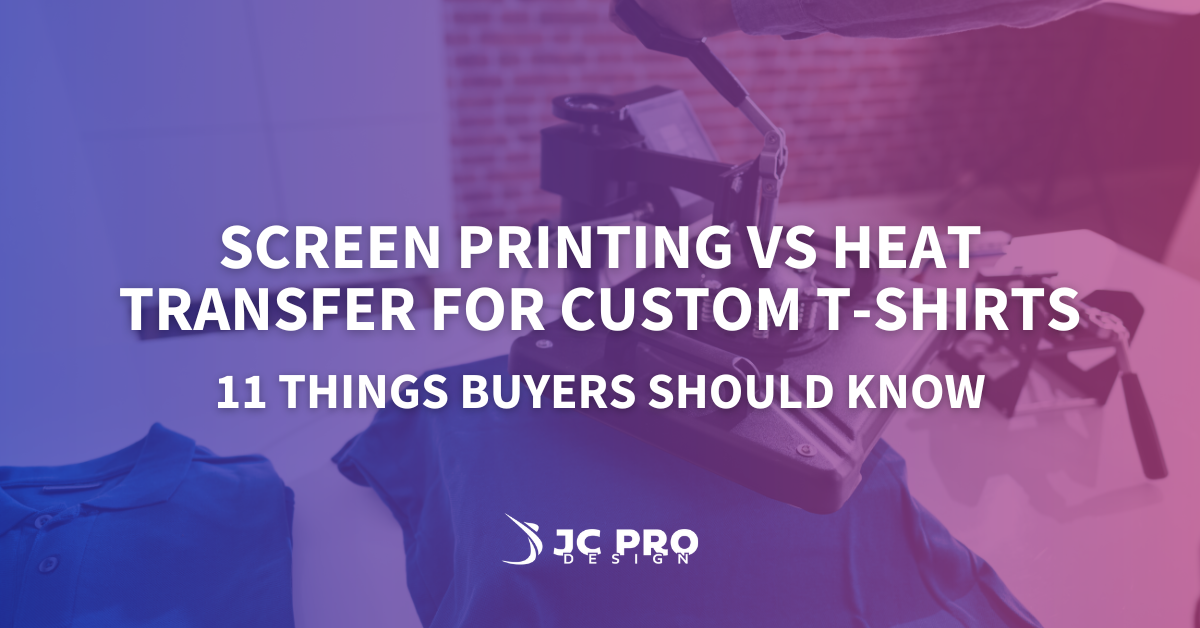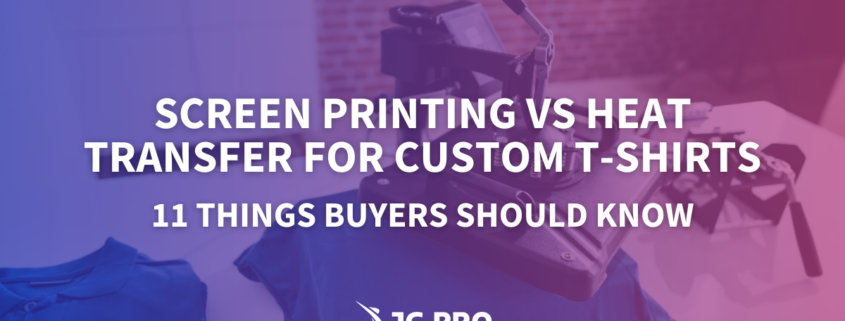Screen Printing vs Heat Transfer For Custom T-Shirts: 11 Things Buyers Should Know
If you’re thinking about getting some custom t-shirts made with your company or team logo, JC Pro Design in Salt Lake City can help you out!
When it comes to t-shirt printing, heat transfer and screen printing are some of the most popular methods. But do you know the difference between the two?
Here are the most frequently asked questions we hear about screen printing vs heat transfer for t-shirts.

1. What’s the biggest difference between heat transfer and screen printing?
Heat transfer prints the design onto a special type of vinyl, and then that design is transferred onto a garment using heat. Screen printing on the other hand uses screens to apply layers of ink directly onto the item of clothing.
2. Which of these methods is best for complex, full color designs?
While we always aim to create the highest quality custom t-shirt printing for businesses in Salt Lake, we recommend heat transfer for more intricate and colorful designs, because it can usually reproduce them with more detail.
3. How durable are the prints from heat transfer and screen printing?
In our experience, heat transfers can be just as durable as screen printing with proper washing, while screen printing can last longer if it is getting washed on really high heat.
4. Which is more cost effective for large orders?
Screen printing is generally more cost effective for large quantities, since we initially create the screen for each color printed in the order, the cost per unit decreases.
5. Can I use either method for dark colored t-shirts?
Yes, both screen printing and heat transfer designs look great on dark colored shirts. There might be some minor differences in vibrancy, since screen printing uses a white ink underbase which typically works better for dark shirts. We also use specific heat transfer vinyls that are made for darker garments.
6. Which technique is faster for small orders?
Heat transfer designs are generally quicker for small orders, since there’s no need for the setup that our screen printing method requires.
7. How does the “hand” or feel of the printed design compare between screen printing and heat transfer?
Screen prints typically feel more integrated into the fabric, while a heat transfer print sometimes feels more noticeable on top of the garment. Smaller designs it is less noticeable compared to large prints.
8. What are the limitations on the types of fabrics I can use with heat transfers and screen printing?
Screen printing works best on natural fibers like cotton, while heat transfers may have some limitations based on the fabric’s heat tolerance.
9. Which of these methods allows for better color matching?
Screen printing lends to more precise color matching, especially when using Pantone colors. Heat transfer may have slight color variations depending on certain conditions. Please contact us if you have any questions for your t-shirt printing needs.
10. Can I use both heat transfer and screen printing on the same shirt?
Absolutely! Although this is less common, some designs may need both methods in order to achieve a particular effect.
11. How do you care for screen printed t-shirts and heat transfer designs?
Generally, we recommend turning your garments inside out before washing, and using cold water can extend the life of the prints for both of these methods.
Ready to bring your custom t-shirt vision to life? Whether you’re leaning towards screen printing or heat transfer, let us guide you to the perfect outcome. Click here and fill out a quick form to receive a tailored quote that matches your vision.


